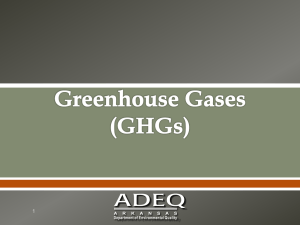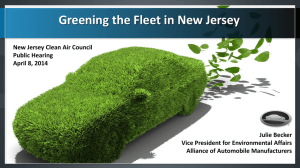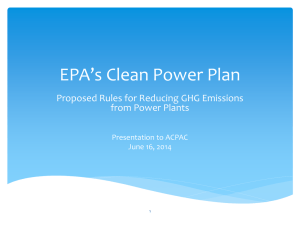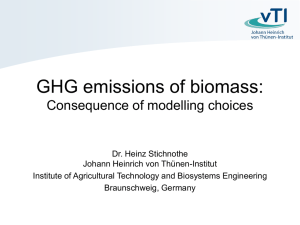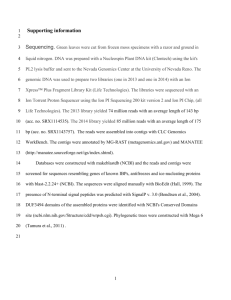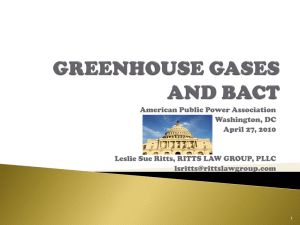GHG Overview
advertisement
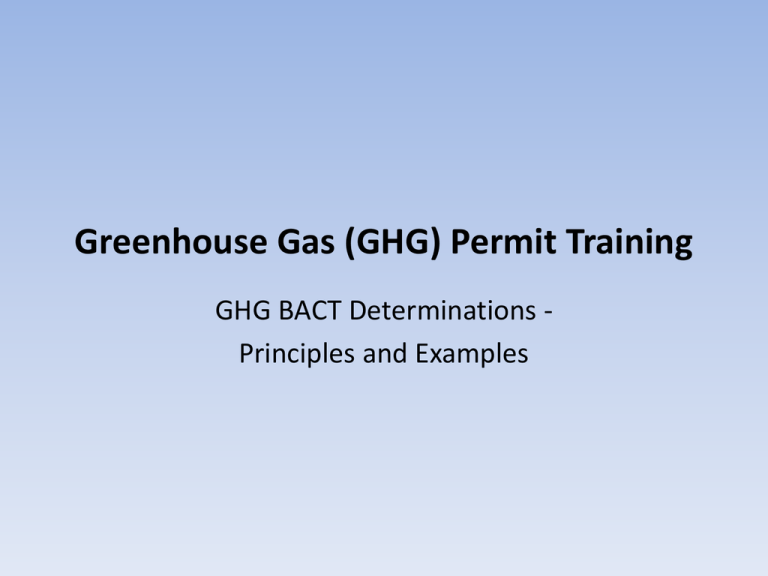
Greenhouse Gas (GHG) Permit Training GHG BACT Determinations Principles and Examples GHG BACT Determinations Top-down BACT Process 1. Identify all potentially applicable controls 2. Eliminate infeasible options 3. Rank controls by their effectiveness 4. Evaluate economical, energy and environmental impacts 5. Select BACT and create permit limits DRAFT 3 BACT in More Detail: Top Down Step 1 Step 1: Identity All Available Controls • Technologies and methods to consider: – Inherently lower emitting processes/practices/designs – Add-on controls – Combinations of inherently lower emitting processes/practices and designs and add-on controls – Methods/controls applied to similar source categories that may be available through technology transfer • Need not consider options that would fundamentally redefine the nature of the source. – “Redefining the source” is a question of degree and within the discretion of the permitting authority. – Assessment begins with consideration of the fundamental business purpose of the project, as described in the permit application DRAFT 4 BACT in More Detail: Top-Down Step 1 Step 1: Identity All Available Controls (cont’d) Consideration of sources of energy in a BACT review: – Consideration of a cleaner version of the primary fuel is not considered redefining the source in most cases. (e.g., it may redefine a mine mouth facility.) – Greater use of a secondary fuel is not considered redefining the source in many instances. – Consideration of a new alternative fuel or energy source may be redefining the source and beyond the scope of a BACT review. DRAFT 5 BACT in More Detail: Top Down Step 1 (cont’d) GHG Considerations – Energy Efficiency • In the near term, options to improve energy efficiency will be the key control technologies for combustion related GHGs. • Often energy efficiency is improved through many actions with small impacts. In that context, it may be impractical to evaluate them individually. • Opportunities to use energy more efficiently, and thereby reduce emissions of GHGs, are appropriate considerations in a BACT review for a new facility. DRAFT 6 BACT in More Detail: Top Down Step 1 (cont’d) GHG Considerations – Benchmarking Efficiency • Data on the energy use/efficiency of similar new units can be used to “benchmark” overall energy efficiency. • Benchmarking data can be used to demonstrate the relative energy efficiency of a facility, process or unit. • The comparison can show whether a unit is a best performer and whether additional reductions may be achievable. DRAFT 7 BACT in More Detail: Top Down Step 1 (cont’d) GHG Considerations (cont’d) • When and how to consider CCS? – Expect CCS to be considered in Step 1 for larger sources of CO2: power plants, cement plants, hydrogen plant, ammonia plant, ethanol plant, ethylene oxide production and iron and steel manufacturing, etc. • Is the use of biofuels a GHG control strategy? – There is no consideration of offsite impacts in Step 1 – Often the CO2 emission rates of biofuels are similar to the fossil alternatives. DRAFT 8 GHG Technology Resources • EPA GHG Technology White Papers – Electric Generating Units, Boilers, Pulp and Paper, Cement, Iron and Steel, Refineries, Nitric Acid Plants http://www.epa.gov/nsr/ghgpermitting.html • EPA GHG Mitigation Strategies Database – currently covers Cement and Electric Generating Units http://www.epa.gov/nsr/ghgpermitting.html DRAFT 9 GHG Technology Resources (cont’d) • ENERGY STAR Guidelines for Energy Management – (www.energystar.gov/guidelines) • ENERGY STAR Industrial Sector Energy Guides – (www.energystar.gov/epis) • EPA’s Climate Leaders Protocols – (http://www.epa.gov/stateply/index.html) • EPA’s Lean and Energy Toolkit – (www.epa.gov/lean/toolkit/LeanEnergyToolkit.pdf) DRAFT 10 GHG Technology Resources (cont’d) • EPA’s Voluntary Partnerships for GHG Reductions: – Landfill Methane Outreach Program (http://www.epa.gov/lmop/) – Coalbed Methane Outreach Program (http://www.epa.gov/cmop/index.html) – Natural Gas STAR Program (http://www.epa.gov/gasstar/index.html) – Voluntary Aluminum Industrial Partnership (http://www.epa.gov/highgwp/aluminum-pfc/index.html) – CHP Partnership Program (http://www.epa.gov/chp) DRAFT 11 GHG Technology Resources (cont’d) • SF Emission Reduction Partnership for the Magnesium Industry – http://www.epa.gov/highgwp/magnesium-sf6/index.html • PFC Reduction/Climate Partnership for the Semiconductor Industry – http://www.epa.gov/highgwp/semiconductor-pfc/index.html • Report of the Interagency Task Force on Carbon Capture and Storage – http://www.epa.gov/climatechange/policy/ccs_task_force.html • As permitting authorities gain experience with GHG BACT determinations, more useful information on GHG permitting decisions will present itself in the EPA’s RACT/BACT/LAER Clearinghouse (RBLC) -- http://cfpub.epa.gov/rblc/ DRAFT 12 GHG Benchmarking Resources The following information sources may be helpful when including benchmarking as part of a BACT analysis. • EPA Energy Star Industrial Energy Management Information Center: http://www.energystar.gov/index.cfm?c=industry.bus_industry_info_center • DOE Industrial Technologies Program: http://www1.eere.energy.gov/industry/ • Lawrence Berkeley National Laboratory Industrial Energy Analysis Program: http://industrial-energy.lbl.gov/ • European Union Energy Efficiency Benchmarks: http://ec.europa.eu/environment/climat/emission/benchmarking_en.htm DRAFT 13 GHG Benchmarking Resources (cont’d) The following information sources may be helpful when including benchmarking as part of a BACT analysis: • IPCC Four Assessment Report: Climate Change 2007: http://www.ipcc.ch/publications_and_data/ar4/wg3/en/ch7.html • ISO TC 207 Standards on Environmental and Greenhouse Gas Management and Related Activities: http://www.iso.org/iso/iso_catalogue/catalogue_tc/catalogue_tc_browse. htm?commid=54808 DRAFT 14 BACT in More Detail: Top Down Step 2 Step 2: Eliminate Technically Infeasible Options Criteria for eliminating a technology: • Not technically feasible (i.e., not demonstrated in practice successfully) • Demonstrated in practice relates to the same type and size of facility or one that has similar processes or emissions stream (for an add-on control) • Technology is infeasible if it cannot be reasonably installed and operated on the source • Should not be eliminated simply because one cannot get a commercial guarantee from a vendor. DRAFT 15 BACT in More Detail: Top Down Step 2 (cont’d) • GHG considerations – Feasibility of CO2 Sequestration – Must consider all three aspects: capture, transport and storage – Site specific considerations include space for equipment, rights of ways for pipelines, access to an appropriate geological reservoir or other storage option DRAFT 16 BACT in More Detail: Top Down Step 3 Step 3: Ranking of Controls • Remaining available, feasible control technologies (and combinations of technologies) are ranked in order of overall control effectiveness for the pollutant under review. • Ranking options include: – Percent pollutant removed – Emissions rate (input- or output-based) – Emissions reduction over time DRAFT 17 BACT in More Detail: Top Down Step 3 (cont’d) Step 3: Ranking of Controls • GHG measures of performance – If plantwide measures to reduce GHGs are considered, alternative measures of overall net emissions impact may be more useful: • Expected emission rate in units such as TPY, lbs/hour, lbs/unit of input or output, etc. • Expected emissions reduction could be expressed in same units • Must consider combinations of controls but not every possible permutation DRAFT 18 BACT in More Detail: Top Down Step 4 Step 4: Economic, Energy and Environmental Impacts How to examine cost effectiveness: • Dollars per ton of emissions eliminated (in CO2e) • Average cost effectiveness and incremental cost effectiveness • Steady state case – Operating cost plus annualizing initial investment – Annual emissions reduction at full capacity • Life time analysis for project – This makes sense when costs and emissions reductions are not steady (e.g., landfills) – Determine life time emissions reductions and costs DRAFT 19 BACT in More Detail: Top Down Step 4 (cont’d) • Cost effectiveness criteria – As with other pollutants, acceptable cost levels for GHG will evolve through permitting experience – Given the large amounts of GHGs, we expect the cost per ton criteria will be lower than for other pollutants • Other economic considerations that are relevant – Cost of control relative to cost of project – Impact on product cost and local job losses DRAFT 20 Cost Effectiveness Example: New Natural Gas Fired Boiler Emissions Analysis: Assumptions Size of Nat Gas Boiler Annual Operating Hours CO2 emission factor CH4 emission factor N2O emission factor GWP CH4 CWP N2O Annual Fuel Use CO2 emissions CH4 emissions N2O emissions 250 MMBTU/hr 8760 53.02 0.001 0.0001 21 310 Hours kg/MMBTU kg/MMBTU kg/MMBTU 2,190,000 116,113,800 2,190 219 CO2 emissions CH4 emissions N2O emissions 128,015.46 2.41 0.24 CO2 emissions CH4 emissions N2O emissions TOTAL 128,015.46 50.70 74.85 128,141.02 DRAFT MMBTU KG KG KG Tons Tons Tons tons CO2e tons CO2e tons CO2e tons CO2e 21 Cost Effectiveness Example: New Natural Gas Fired Boiler (cont’d) Measure Efficiency Benefit (Fuel Savings) Capital Cost Annualized Capital Cost Operating Fuel Savings and Maint. Costs Annual Cost or Savings CO2e Emissions Reduction C/E $/ton Oxygen Trim 1% $100K $16.3K -78.8K +$25K -$37.5K 1,281 NA Economizer 5% $1,000K $163K -$395K +$75K -$157K 6,405 NA Blowdown Heat Recovery 0.3% $400K $67.2K -$23.6K +$50K +$93.6K 384.3 $243 /ton DRAFT 22 BACT in More Detail: Top Down Step 4 (cont’d) • Energy impacts: Both the energy use and its economic implication are addressed. Direct energy impacts (e.g., cost of fuel) as well as indirect energy impacts (e.g., fuel scarcity). Purchased electricity is addressed at this point • Other environmental impacts: – Solid and hazardous waste generation, wastewater discharges, visibility impacts, demand on local water resources or emissions of unregulated pollutants. – Both on site and off site impacts considered • Historically, the economic impact has been the most common basis for putting aside the most effective control as not being BACT. Energy and environmental collateral impacts have been rarely a factor in the BACT decision process. DRAFT 23 BACT in More Detail: Top Down Step 4 (cont’d) • GHG Issues – Impacts of CCS on energy use and related emissions – Weighing of possible trade-offs of criteria pollutants and GHGs – Biofuel off site impacts - treatment of emissions for BACT purposes is still under review by EPA • Permitting authority has discretion in the determining the weight given to the particular impacts under consideration. • Consideration and rationale must be documented. DRAFT 24 BACT in More Detail: Top Down Step 5 Step 5: Selecting BACT • Determining BACT: – Should be the most effective control option not eliminated in Step 4 • Permit Conditions – – – – Emissions limit Equipment specifications Work practices Monitoring, recordkeeping and reporting DRAFT 25 BACT in More Detail: Top Down Step 5 (cont’d) • GHG Considerations – Output based limits can be a useful means of capturing the impact of a multitude of energy efficiency measures – Longer averaging periods may be appropriate for GHGs and are useful in dealing with variations related to load, malfunctions and start-up and shutdown. – Design requirements and work practices may be needed to create practical enforceable conditions for individual efficiency measures. DRAFT 26 Recap of EPA Perspective on Technology Issues • Energy Efficiency – Measures that reduce on site energy use: Should be Considered in Step 1 – Measures that reduce off site energy use: Should be Considered in Step 4 • Biofuels – On site GHG emissions: Relevant in Step 1 – Off site GHG emissions impacts: Relevant in Step 4 – Other environmental impacts: Relevant in Step 4 DRAFT 27 Recap of EPA Perspective on Technology Issues (cont’d) • Carbon Capture and Storage (CCS) – May be considered an add-on control – Three key components: • Transport, • Capture and • Storage (sequestration) – Technical feasibility: Relevant to Step 2 – Cost: Relevant to Step 4 – Other impacts on energy use and environment: Relevant to Step 4 DRAFT 28
